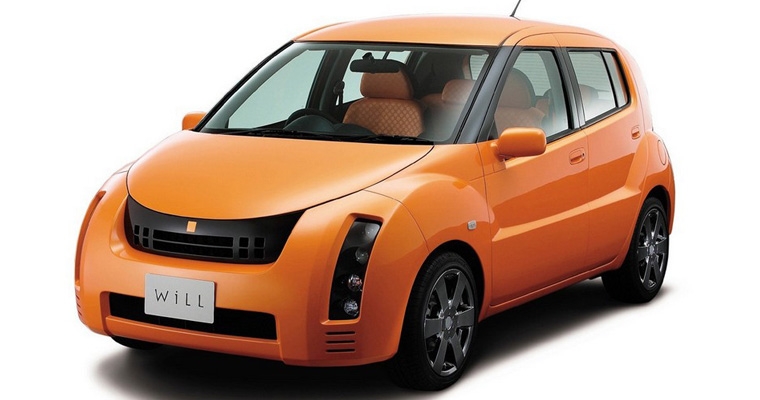

Toyota Will
The WiLL brand was a marketing approach shared from a small group of Japanese companies who decided to offer products and services that focused on a younger demographic from August 1999 until July 2004 in Japan. The companies that participated were the Kao Corporation (a manufacturer of personal hygiene, household detergents, and cosmetics), Toyota, Asahi Breweries, Panasonic, Kinki Nippon Tourist Company, Ltd, Ezaki Glico Candy, and Kokuyo Co., Ltd. (an office furniture and stationery manufacturer). Toyota also engaged in a similar "youth oriented" approach in North America, with the Project Genesis program.
The WiLL vehicles
Toyota offered three individually designed cars, based on the mechanicals of existing Toyota models. The series was intended to appeal to markets that were not covered by Toyota's mainstream range, and to discover how commercially feasible such unusual designs were. The American Scion range is based on a similar concept.[1] All WiLL vehicles were only sold in Japan, and only at Toyota Vista Store locations. When the WiLL project ended in 2004, Toyota stopped producing WiLL branded vehicles, and renamed the Toyota Vista dealerships to Toyota NETZ, that coincided with the launch of the North American introduction of Scion, using lessons learned from the WiLL project.
WiLL Vi
The WiLL Vi is a compact car, produced from 2000 to 2001, with distinctive styling combining elements of many cars. The WiLL Vi was designed by the then newly formed Virtual Venture Company, headed by Jim Shimizu.[1] The unique-appearing rear window had earlier appeared on the Mazda Carol, the Ford Anglia (1959–1968), and the Citroen Ami. The "neo-retro" look represented a period in Japan where vehicles took on the styling of historic vehicles from the 1950s and 1960s, such as the Nissan Be-1, Nissan Figaro, Nissan Pao, the Toyota Origin, the Subaru Vivio, and the Mitsubishi Minica.
The car was equipped with MacPherson struts for the front wheels and a torsion beam axle for the rear wheels. The car was painted in a number of pastel colors, and the plastic wheel covers resemble sand dollars. One of the few options was a canvas sliding roof, and the vehicle was installed with bench seats for both front and rear passengers, with the gearshift installed on the dashboard.
Sales were disappointing, so the Vi was replaced by the WiLL Cypha.
WiLL VS
The WiLL VS was years ahead of its rivals in car design when it was first introduced in 2001. It was formally introduced at the 2001 Los Angeles Auto Show, as a precursor to the introduction of Scion to North America. It was manufactured at Kanto Auto Works.[2] Inspiration for the design of the WiLL VS was said to have been derived from the Lockheed F-117 Nighthawk Stealth Fighter.
The WiLL VS came in three levels of trim. The top of the range model came with alloy wheels, fog-lamps, body kit and tiptronic gearshift. Models are available in automatic transmission, tiptronic, and a six speed manual, powered by Toyota's 1800cc VVT-I engine offering 140 hp or VVTL-I engine offering 180 hp, which is the unit in the higher spec Toyota Celica. The VS joined the revised Vi, renamed the Cypha, and offered WiLL buyers the choice of a wider car with a more powerful engine. The width dimensions of the VS exceeded Japanese Government regulations that taxed vehicles based on exterior dimensions, which buyers of the VS were liable.
In spite of its success in the Japanese market, where the WiLL VS had a cult following, the model was never released overseas. Production of the WiLL VS was stopped circa 2004 and a replacement model was never announced, much to the disappointment of its fans. Nevertheless, some would argue that there was no need to replace the WiLL VS for at least another decade given its futuristic design that some of the newer cars were only beginning to adopt. This would include trend-setting features such as the rakish body shape, aerodynamic angles, projector-style headlamp cluster (regarded as revolutionary in 2001), illuminated speedometer and clear LED tail lights.
The car was used as the police vehicle "Machine Bull" in the 2004 Super Sentai series Tokusou Sentai Dekaranger.
The WiLL VS will probably be remembered as one of the few concept vehicles that went into production, albeit only in small numbers, only 4,000 were ever produced. In the years to follow, several other vehicles have taken styling cues from the WiLL VS, most notably the 2004 Vauxhall Astra and the Renault Megane.
WiLL VC and WiLL Cypha
The WiLL VC, later WiLL Cypha was produced from 2002 to 2005. It shared many of its mechanicals, including the 1.3-litre 2NZ and 1.5-litre 1NZ engines, with the Ist. Its styling developed themes seen in the Vitz/Yaris, but has a more angular look, a continuation of the short-lived WiLL Vi. Notable features are the rear lights placed level with the rear window, giving a look of the Renault Megane II, and the distinctive headlights which have four lamps per side arranged vertically. The interior used a rounded theme, with items such as the door pulls and the central console being circular. All Will VC' and WiLL Cyphas were manufactured by Central Motors at its "Headquarters plant" located at Ohira, Miyagi, Japan. The Cypha (the words "cyber" and "phaeton" combined)[3] was one of the first Toyota vehicles to be installed with their vehicle telematics system called G-Book. The vehicle was also promoted with a sales approach called "pay as you go" meaning that you were given the option not to buy the car with monthly payments, but to instead lease the car, and only pay a monthly bill based on how far you drove in a month. When the driver no longer wanted the vehicle, they returned the car to the Toyota dealership.








